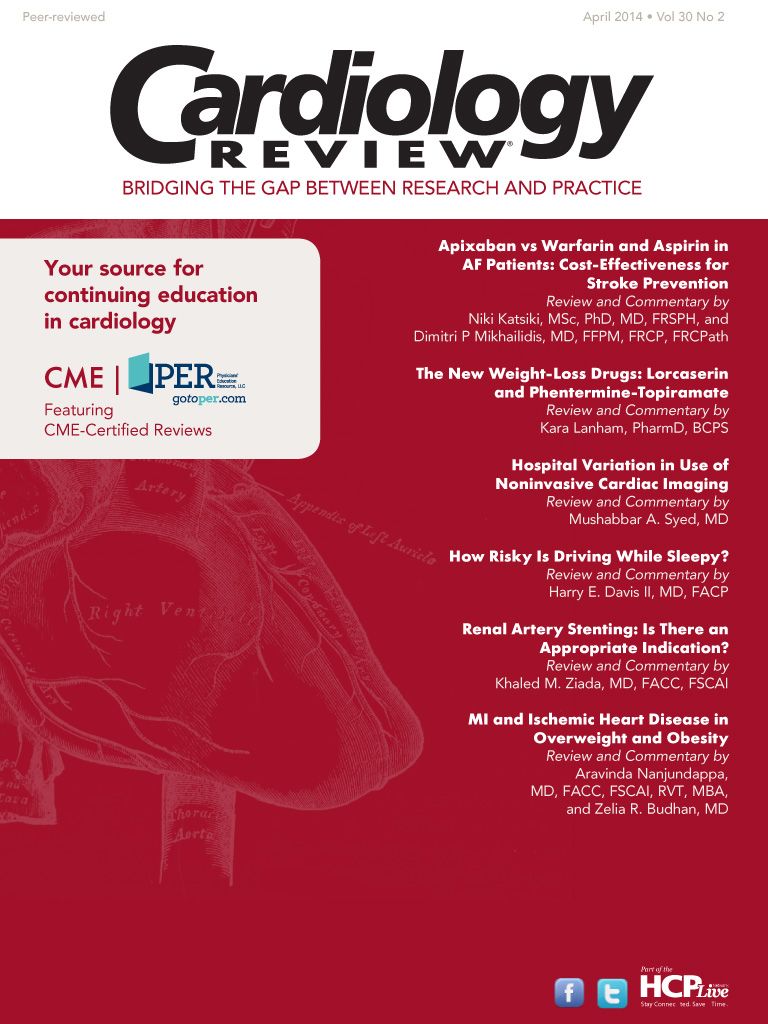Do You Support the New Cholesterol Guidelines and Risk Calculator?
In this edition of Clinical Forum, we asked Cardiology Review editorial board members and an invited guest to comment on the controversial new cholesterol guidelines and risk calculator issued by the American Heart Association (AHA) and American College of Cardiology (ACC) in November 2013.
In this edition of Clinical Forum, we asked Cardiology Review editorial board members and an invited guest to comment on the controversial new cholesterol guidelines and risk calculator issued by the American Heart Association (AHA) and American College of Cardiology (ACC) in November 2013.Please send your comments or suggestions for future Cardiology Review Clinical Forum questions to Dr Mukherjee at debabrata.mukherjee@ttuhsc.edu. Space permitting, we will post them online and in the iPad edition of the next issue.
Q: Do you support the new cholesterol guidelines and risk calculator that were issued by the AHA and ACC in November 2013?

Alison L. Bailey, MD, FACC
Associate Professor of Medicine
Director, Cardiac Rehabilitation
Gill Heart Institute
University of Kentucky
Lexington, KY
A: In 2008, the National Heart Lung and Blood Institute (NHLBI) began work on an updated cholesterol guideline—the Adult Treatment Panel IV. The goal was to incorporate the new data regarding reduction of cholesterol and clinical benefit. Along the way, the NHLBI decided that clinical guidelines may not be the best use of its resources. In 2013, a collaboration was formed with the American Heart Association (AHA) and the American College of Cardiology (ACC) to complete and publish this guideline. The result is the 2013 ACC/AHA guideline on the treatment of blood cholesterol to reduce atherosclerotic cardiovascular risk in adults: a report of the American College of Cardiology/American Heart Association Task Force on Practice Guidelines.1
Anyone familiar with other ACC/AHA guidelines will notice the differences between this guideline and others. Notably, it only uses the highest quality, randomized, controlled trial data to form the majority of recommendations, with little use of extrapolated data or expert recommendations. This is in stark contrast to the majority of ACC/AHA guidelines in which only a median of 19% contained “A”-level evidence on which to base recommendations.2 A clinical guideline should be user friendly and sum up the existing data in a logical way that includes both a high-quality review of data as well as the interpretation of this data by experts for an optimal patient management document. This document may fall short of this goal.
- What are the biggest changes in this guideline?
- No target low-density lipoprotein cholesterol (LDL-C) goal
- Use of moderate- or high-intensity statin therapy in those most likely to benefit based on 4 major statin-benefit groups determined by the presence of clinical atherosclerotic cardiovascular disease (ASCVD), elevated LDL, diabetes mellitus, or “high-risk” primary prevention groups that are based on estimated risk
- New Pooled Cohort Equations to estimate 10-year ASCVD risk3
- No recommendation for any non-statin therapy
While the overall message of this guideline (use moderate- to high-intensity statins in groups that will achieve the most benefit according to strong clinical trial evidence) will undoubtedly benefit our patients, I think ignoring LDL levels completely ignores a substantial tenet of this same trial data. There have been consistent themes in the trials reviewed by the committee: significant, clinically meaningful reductions in ASCVD in patients receiving moderate- to high-dose statins and LDL lowering— even in these groups already on moderate to high intensity statins—is associated with clinical benefits.4
The decision not to use LDL targets even in some small way essentially ignores a large body of strong clinical evidence suggesting benefit with lower achieved LDL level. This decision was likely based on several factors, including the desire to make the guideline simple and more user-friendly to the masses as well as the controversy that exists regarding non-statin therapies in reducing LDL. However, the result has been controversy and strong feelings from many in the medical community regarding the lack of comment on these topics.
The introduction of a new risk calculator has also stirred controversy, with recent analysis suggesting overestimation of 10-year risk in most contemporary primary-prevention cohorts.5 This risk calculator was validated in cohorts that may not have been as healthy as our contemporary patient populations. The concern is increased statin use in groups that may not derive benefit (low-risk). This represents a valid concern; however, in the current era of inexpensive statin options and lower side effect profiles, I think this is of less controversy overall.
In conclusion, this document advances the concept that we should be using more moderate- to high-intensity statins in our patients, and this is strongly supported by evidence. However, it ignores some of the other central tenets seen in high-quality research over the years and brings into play a risk calculator that is controversial. All in all, we, as a medical community, have mixed thoughts about the guideline. Our patients sense this controversy, and this can have detrimental effects with respect to recommendations for risk reduction with statins.
References
1. Stone NJ, Robinson J, Lichtenstein AH, et al. 2013 ACC/AHA guideline on the treatment of blood cholesterol to reduce atherosclerotic cardiovascular risk in adults: a report of the American College of Cardiology/American Heart Association Task Force on Practice Guidelines [published online November 12, 2013]. Circulation. http:// circ.ahajournals.org/content/early/2013/11/11/01.cir.0000437738.63853.7a.citation.
2. Tricoci P, Allen JM, Kramer JM, Califf RM, Smith SC Jr. Scientific evidence underlying the ACC/AHA clinical practice guidelines. JAMA. 2009;301:831- 841.
3. American College of Cardiology. Cardiosource. 2013 Prevention Guidelines ASCVD Risk Estimator. www.cardiosource.org/science-and-quality/practice- guidelines-and-quality-standards/2013-prevention- guideline-tools.aspx.
4. Baigent C, Blackwell L, Emberson J, et al. Efficacy and safety of more intensive lowering of LDL cholesterol: a meta-analysis of data from 170,000 participants in 26 randomised trials. Lancet. 2010;376:1670-1681.
5. Ridker PM, Cook NR. Statins: new American guidelines for prevention of cardiovascular disease. Lancet. 2013;382:1762-1765.
Q: Do you support the new cholesterol guidelines and risk calculator that were issued by the AHA and ACC in November 2013?

Ragavendra R Baliga, MD, MBA, FACP, FRCP, FACC
Associate Director, Division of Cardiovascular Medicine
Professor of Internal Medicine
Wexner Medical Center
Columbus, OH
A: Given that most statins are now generic and hence less expensive, the AHA/ACC guidelines released in Nov 2013 recommended that statins be utilized for primary prevention in individuals with at least a 7.5% 10-year risk of developing cardiovascular disease and be considered for those with a 5%-7.5% 10-year risk.1 The risk is to be computed using a new prediction algorithm developed by the ACC/AHA. The predictive value of this algorithm has been disputed, with critics of the algorithm stating that the risk may be overestimated by as much as twofold because this global prediction model is based on data for which crucial evidence remains to be collected. Other concerns expressed include the fact that the risk algorithm is based on classic risk factors and ignores newer risk markers such as C-reactive protein (CRP) and those derived from imaging modalities, and concerns that there is an overemphasis on statin therapy resulting in unintended consequence of ignoring lifestyle measures such as smoking cessation, weight loss, and exercise. Writers of the guideline refute the charge that it overestimates risk because they say that the critics used a healthier-than-typical population to verify the predictive value of this algorithm. Others have called for clinical trials to determine the best predictive algorithm and the ideal threshold for therapy, or, at a minimum, ensure that there is frequent calibration of the predictive algorithm to accurately reflect the changing demographics of the population.
Three other major changes in the guidelines include the following:
- The abandonment of low-density lipoprotein cholesterol (LDL-C) targets, making it difficult to assess the adequacy of therapy and follow-up management. This also means that routine assessments of LDL-C and use of surrogate markers such as CRP and calcium scores may not be necessary for those on statin therapy. The justification to move away from explicit goals for LDL-C and high-density lipoprotein cholesterol (HDL-C) as recommended in ATP-III is based on current best evidence from a synthesis of epidemiologic, genetic, and pharmacologic data, randomized trial findings, and laboratory data.
- An emphasis on high-intensity statin therapy, raising the question whether the statin dose should be increased in an individual at risk who has been stable for years with moderate- intensity statin therapy.
- Given a lack of data about individuals above age 75 years when they have no clinical atherosclerotic disease, there are no recommendations for how to treat these individuals.
The utilization of this new predictive model is expected to mean that there will be 33 million more US adults recommended for high-intensity statin therapy (those with a 10-year predicted risk of >7.5%), another 13 million individuals (with a risk of 5%-7.4%) who may be considered for statin-based treatment, and many individuals without dyslipidemia (or who have “normal” levels) who will be eligible for statin therapy based on their risk profile.2 Based on National Health and Nutrition Examination Survey (NHANES) data, it is estimated that more than one-third of white males and over half of African American males belong to categories that make them candidates for statin treatment. Although these numbers sound staggering, the implementation of these new guidelines do not appear to be aggressive given that one-third of Americans die with cardiovascular disease and 60% are afflicted by major vascular events including nonfatal strokes. The utilization of these guidelines worldwide, however, may be premature until a valid risk prediction score is available for individuals in low- and middle-income countries with different ethnicities.
Overall, these guidelines are based on current evidence and make sense because most statins are now inexpensive, are generally safe, and have a substantial impact on reducing morbidity and mortality due to cardiovascular disease.
References
1. Stone NJ, Robinson J, Lichtenstein AH, et al. 2013 ACA/AHA guidelines on the treatment of blood cholesterol to reduce atherosclerotic cardiovascular risk in adults: a report of the American College of Cardiology/ American Heart Association Task Force on Practice Guidelines [published online November 12, 2013]. Circulation. http://circ.ahajournals.org/content/ early/2013/11/11/01.cir.0000437738.63853.7a.citation.
2. Pencina MJ, Navar-Boggan AM, D’Agostino RB, et al. Application of new cholesterol guidelines to a population-based sample [published online March 19, 2014]. N Engl J Med. 2014. doi:10.1056/NEJMoa1315665.
Q: Do you support the new cholesterol guidelines and risk calculator that were issued by the AHA and ACC in November 2013?

Sucheta Gosavi, MD
Assistant Professor of Internal Medicine
Texas Tech University Health Sciences Center
El Paso, TX
A: The new cholesterol guidelines1 published in November 2013 have been surrounded by a great deal of controversy because of its use of a new heart risk calculator for calculating the 10-year risk of developing atherosclerotic cardiovascular disease (ASCVD), as well as for its recommendation to administer statins for primary prevention and not only for secondary prevention in ASCVD.
The heart risk calculator uses new pooled cohort equations to estimate the 10-year ASCVD risk in white and black men and women. However, the data used to establish the equation were gathered from randomized controlled trials (RCTs) data rather than observational studies. Thus, one of the criticisms of the heart risk calculator is that it over- or underestimates risk in some persons. This is because the RCTs have a selection bias and results cannot always be extrapolated to the general population.2 The Cochrane meta-analysis3 and Cholesterol Treatment Trialist4 studies confirm that statins used for prevention reduce total mortality as well as nonfatal events. As noted by Ridker and Cook,5 all the data used were from RCTs from 1995 to 2008, and the use of global risk score was not applied during enrollment into these studies. Thus there is discrepancy in the risk estimates by the heart risk calculator. Allan et al compared the risks for atherosclerotic disease in 25 different calculators using the same hypothetical patients and found variability in the results.6 Therefore, all risk calculators have some errors and should be used as a base from which to start the discussion about decreasing 10-year risk of ASCVD.6
The previous ATP III guidelines (2004) identified 32.9% of patients as needing primary prevention because they had 10% 10-year risk of CV disease. With the new calculator about 31.9% of patients warrant intervention because they have a 7.5% 10-year risk. Thus there is no major increase in the population who need primary prevention due to aggressive lifestyle interventions such as controlling obesity, improving diet, and exercising that occurred over the last few decades, although the threshold of risk estimation is lowered from 10% to 7.5%.7
Concerns have been voiced that an increased number of people would now need statins for primary prevention. It has been calculated that about 33 million people in the 40- to 79-yearold age group have a 7.5% or higher 10-year predicted risk and about 13 million have a 5%- 7.5% 10-year predicted risk in the United States (approximately 1 billion in the world).8 The side effects of high- and moderate-dose statins, especially on different races and ethnicities, is not being considered by the risk calculators. Some of these potential side-effects are elevated liver enzymes, significant myopathies, and possible early short-term memory loss.
Victor Monteri et al9 commented on the fact that decreasing the LDL level should not be considered the only metric for decreasing the ASCVD risk. The physician’s performance should not be assessed based only on controlling the LDL <100 mg/dL as it will drive physicians to encourage more patients to take statins instead of modifying other risk factors.
The most important take-home message is that the new cholesterol guidelines have encouraged statins not only for secondary prevention, but also for primary prevention as a public health measure along with other risk factor modifications to decrease the ASCVD risks. The physician and the patient should make a combined decision after calculating the risks and understanding the side-effects prior to starting statins as a prevention strategy for ASCVD.
References
1. Stone NJ, Robinson J, Lichtenstein AH, et al. 2013 ACA/AHA guidelines on the treatment of blood cholesterol to reduce atherosclerotic cardiovascular risk in adults: a report of the American College of Cardiology/ American Heart Association Task Force on Practice Guidelines [published online November 12, 2013]. Circulation. http://circ.ahajournals.org/content/ early/2013/11/11/01.cir.0000437738.63853.7a.citation.
2. Feeman WE Jr. Refining the American guidelines for prevention of cardiovascular disease. Lancet. 2014;383:599.
3. Taylor F, Ward K, Moore TH, et al. Statins for the primary prevention of cardiovascular disease. Cochrane Database Syst Rev. 2011(1):CD004816. doi:10.1002/14651858.CD004816.pub4.
4. Cholesterol Treatment Trialists (CTT) Collaborators. The effects of lowering LDL cholesterol with statin therapy in people at low risk of vascular disease: meta-analysis of individual data from 27 randomized trials. Lancet. 2012;380:581-590.
5. Ridker PM, Cook NR. Statins: new American guidelines for prevention of cardiovascular disease Lancet. 2013;382:1762-1765
6. Allan GM, Nouri F Korowynk C, Kolber MR, Vendermeer B, McCormack J. Agreement among cardiovascular disease risk calculators. Circulation. 2013;127:1948-1956.
7. Patsy BM, Weiss NS. 2013 ACC/AHA guideline on the treatment of blood cholesterol: a fresh interpretation of old evidence. JAMA. 2014;311:461-462.
8. Ioannidis JPA. More than a billion people taking statins? potential implications of the new cardiovascular guidelines. JAMA. 2014;311:463-464.
9. Montori VM, Brito JP, Ting HH. Patient-centered and practical application of new cholesterol guidelines to prevent cardiovascular disease. JAMA. 2014;311:465-466.
Q: Do you support the new cholesterol guidelines and risk calculator that were issued by the AHA and ACC in November 2013?

Marian C. Limacher, MD, FACC, FAHA, FACP
Professor of Medicine
AHA Endowed Professor of Cardiovascular Research
Director, University of Florida CTSI Training and Professional Development Program
University of Florida
Gainesville, FL

JoAnn E. Manson, MD, DrPH, FAHA, FACP
Chief, Division of Preventive Medicine, Brigham and Women’s Hospital
Professor of Medicine
Michael and Lee Bell Professor of Women’s Health
Harvard Medical School
Boston, MA
A: We are supportive of the overall approach and recommendations of the 2013 ACC/AHA Guideline on the Treatment of Blood Cholesterol to Reduce Atherosclerotic Cardiovascular Risk in Adults.1 We believe it is important to acknowledge the comprehensive assessment and synthesis of evidence undertaken by the writing group. One of the key elements of the new approach represents a paradigm shift from recommending specific treatment targets to using fixed medication doses with anticipated effects. Findings from numerous published clinical treatment trials provide a compelling rationale for the new approach. However, the implementation of this change in practice will take time, as systems developed around the National Cholesterol Education Program recommendations2 were widely adopted in medical practices and have become ingrained in patient understanding as well.
The new algorithms from the 2013 guideline have some complexity and will require tools to assist their use in clinical practice. Although electronic health records have great potential for facilitating use of these algorithms, the actual implementation of effective and efficient automated alerts and patient management schemes will need to be developed and tested—something that has not generally occurred in most practice locations for any other health applications. The guideline does provide helpful practical guidance for initiation and monitoring medications, as well as addressing potential side effects. The current version of the risk calculator adds stroke outcomes to the assessment of atherosclerotic cardiovascular disease (ASCVD) risk; this is a welcome addition that will have meaning for both practitioners and patients. The availability of applications for mobile devices will increase the clinical usefulness of the risk calculator.
One of the most controversial aspects of the 2013 guideline is the setting of a 7.5% 10-year risk as the trigger for intervention with statins. Ultimately, the impact of this strategy will require ongoing monitoring, and, it is hoped, rigorous study over the coming years. We strongly endorse the recommendation for close monitoring of outcomes over long periods of follow-up, and we plan to conduct such a study in a large-scale multiethnic cohort. As the authors of the guidelines point out, longterm effects from the use of statins for over 15 years are not yet available. Likewise, identification of other treatment options must continue. Most importantly, we must not lose sight of the core message of achieving ideal cardiovascular health through adopting recommended lifestyle behaviors. In addition, the guideline clearly emphasizes that individual clinical judgment and shared decision making with the patient are needed prior to initiating specific interventions. Clinicians first should be familiar with the recommendations, but then provide balanced information to engage in a risk discussion with the individual patient and ultimately to decide together on the best option for managing risk.
References
1. Stone NJ, Robinson J, Lichtenstein AH, et al. 2013 ACA/AHA guidelines on the treatment of blood cholesterol to reduce atherosclerotic cardiovascular risk in adults: a report of the American College of Cardiology/ American Heart Association Task Force on Practice Guidelines [published online November 12, 2013]. Circulation. http://circ.ahajournals.org/content/ early/2013/11/11/01.cir.0000437738.63853.7a.citation.
2. Expert Panel on Detection Evaluation and Treatment of High Blood Cholesterol in Adults. Executive summary of the Third Report of the National Cholesterol Education Program (NCEP) Expert Panel on Detection, Evaluation, and Treatment of High Blood Cholesterol in Adults (Adult Treatment Panel III). JAMA. 2001;285:2486-2497.
